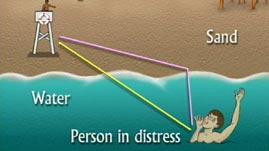Teachers' Domain - Digital Media for the Classroom and Professional Development
User: Preview

Source: Harvard—Smithsonian Center for Astrophysics
In this video segment adapted from Shedding Light on Science, learn about the refraction of light. Observe how a straight straw placed in a bowl of water appears to bend where it enters the water. Learn about how the speed of light changes in different transparent materials and the direction of the light changes at the boundary of the materials. Fermat's principle of least time is explained through the analogy of a lifeguard on a beach trying to reach a swimmer in the water in the least amount of time.
In a given material, light travels in a straight path. However, when light leaves one transparent substance and enters another substance with a different index of refraction (a measure of how much the speed of light is slowed in that material), it may bend. If the light enters the new material at an angle other than perpendicular to the boundary, the path of light changes direction. This is called refraction. The bending of light can be understood by Fermat's principle, which states that light always takes the path of least time. In other words, of all the paths that light could take between two points, it takes the path that requires the least amount of time, even if it is not the shortest path by distance.
For example, consider the analogy of a beach lifeguard who needs to get from her spot on the beach to a distressed swimmer in the water. Because she can run faster on the sand than she can swim in the water, the path that takes the least amount of time is not necessarily a straight line to the swimmer. The lifeguard may reach the swimmer in a shorter amount of time by taking a bent path—running a longer distance in the sand and then turning and swimming a short distance in the water.
Similarly, light also takes the path of least time between two points. Light travels at a speed of about 300,000 km/sec in a vacuum, but the density of a substance affects the speed at which light travels through it. A change in material causes a change in the speed of light, which causes the path of the light to bend. Of course, rays of light cannot think and do not plan their path—the principle of least time is simply a way of thinking about how to describe the behavior of light.
The change in direction of light as it passes from one material to another is the foundation of all optical devices. By understanding refraction, scientists have developed lenses that reduce, magnify, focus, and disperse optical images. Eyeglasses, microscopes, and cameras all depend on bending light as it passes from air into glass and back into air.
Refraction can distort one's line of sight. For example, mirages are caused by light passing from hotter into relatively cooler air and refracting in the process. The change in temperature changes the density of the air and therefore the speed of the light passing through it. As a result, strange effects may be seen; for instance, when light from a distant mountain changes direction before it reaches your eyes, the mountain may appear to be hovering above the horizon.
 Loading Standards
Loading Standards Teachers' Domain is proud to be a Pathways portal to the National Science Digital Library.
Teachers' Domain is proud to be a Pathways portal to the National Science Digital Library.
